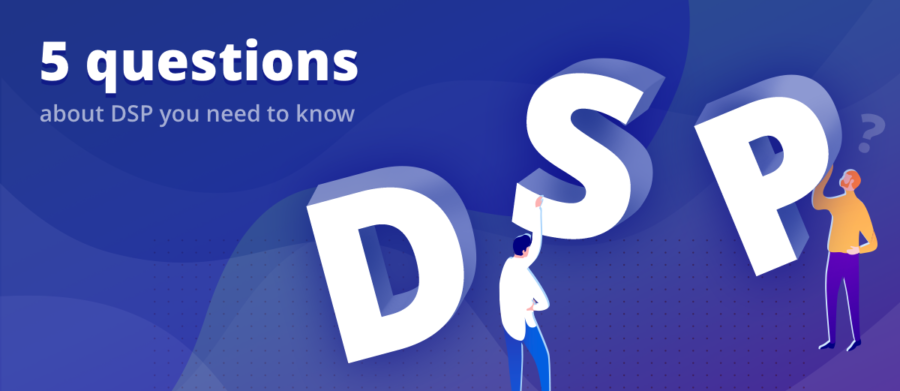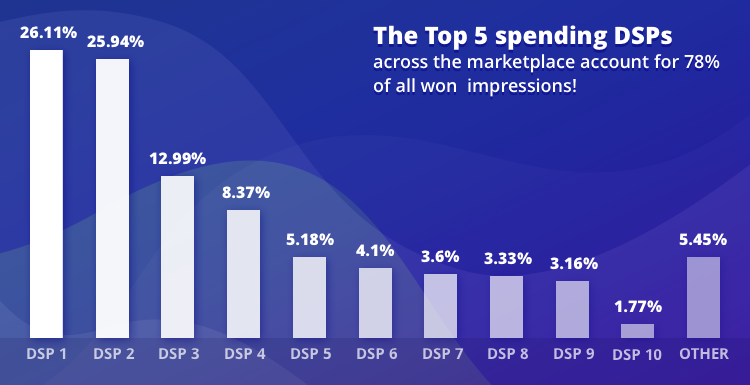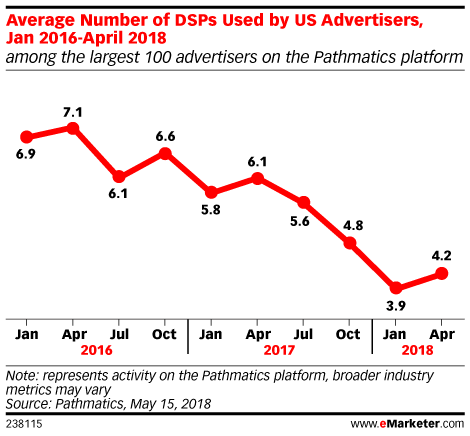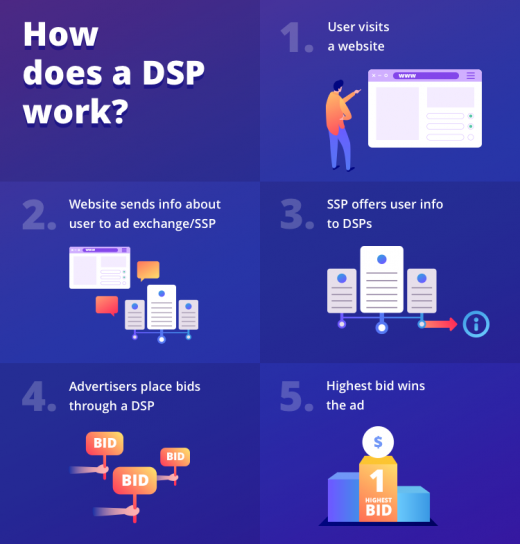5 Things About Demand Side Platforms You Need to Know
— August 3, 2018

What is a DSP? Should you use it? Is it cost-effective to build your own DSP? How do you choose a good third-party solution? We’ve compiled a list of the most common questions advertisers have about DSPs. You’ll also learn how such a platform can help your business.
Long gone are the days when a user saw a multitude of irrelevant ads due to the poor targeting options (GEO, age, gender and basic interests were the only options available). Media buying evolved into audience buying: every business aims at getting the most relevant audience at the lowest price possible.
However, with this evolution, buying via third-party companies became risky: non-transparent deals resulted in the increase of fraudulent traffic.
And that’s when DSPs came to the scene.
Why you should use a DSP for online advertising
DSP is a technology platform that gives RTB access to multiple sources of inventory and allows the option to buy the relevant audience programmatically. Instead of putting ads anywhere, DSPs decide which impressions are most valuable for your campaign.
You need a DSP when you operate with decent traffic volumes and want total control over bidding and campaign management, all while tracking the best possible advertising opportunities within one platform.
How does a DSP work?

Through SSP, a publisher transfers impressions to ad exchanges. The latter passes it to a DSP, which then evaluates the impression according to the targeting settings, cookie matching, and pricing. If the impression is valuable (the visitor falls under target audience settings), a DSP would bid on this impression.
“Bid on the impression” means submitting the highest price that the advertiser is ready to pay for showcasing an ad in front of that user. With RTB technology, there’s no need to negotiate prices with the publishers, as all of this is done automatically. Among hundreds of DSP bids the impression with the highest bid will be chosen by SSP for ad display. All this process is done in mere milliseconds.
What are the key features of a DSP?
- Transparency is crucial for your DSP evaluation. With a full suite of reporting available, you can optimize your campaigns and get on the road to true media buying efficiency.
- Queries per second (QPS) is the metric reflecting how many times a DSP gets called to make a bid on an ad placement to reach a user. A higher QPS represents the speed and frequency of analyzing and acting on those bids. It’s a simple numbers game: the greater the scale of an ad campaign – the higher bidding visibility it will drive. It provides decision engines with more information. After making a bid to reach a unique user at a specific price, the DSP learns if the price was accepted. If the price was not accepted, the DSP is made aware that it may require a higher price to win future bids. However, many DSPs have poor traffic filtering options which means they can bid on the same publisher’s traffic across multiple ad exchanges. The high amount of QPS means duplicate-free impressions.
- Real-time analytics. DSP interface should be as close to real time as possible – you need the most recent stats to see the campaign performance. Decide if the “real-time” is crucial for your business and ask DSPs you consider using, how big is the delay in analytics. For example, Appnexus have an hour delay in analytics, while Epom DSP has a 1.5 sec delay.
- Variety of ad formats. A very important criterion of DSP evaluation is the ability to run omnichannel advertising campaigns with non-standard ad formats like popups, popunders, or rich media. Since DSPs are incurring large costs on impression processing, they are usually focused on one particular channel (eg. desktop display) more than others. Define the top 2-3 ad channels that your advertisers need and filter DSPs according to it.
- Pricing. The cost of using a DSP often depends on the size of a campaign, or the media budget you commit to the platform. Some DSPs charge a flat fee while others take the commission on volume. The DSP giants like Beeswax charge a minimum of $ 8500 monthly fee +5% revenue share, so if the pricing plan scares you, consider smaller vendors (Amobee, AdSpirit, White Label DSP). Before partnering with a DSP, clarify if there are any additional fees for the DSP’s support staff to set up and optimize your campaigns, and also understand if you should pay for the advanced data.
Should I build my own DSP?
Even with the rapidly changing digital advertising landscape and enormous competition, there are numerous people on Quora saying “Want to build something amazing – build it by yourself”. I found two issues worth taking into account BEFORE starting the DSP development process.
Competition issue
After the rise of header bidding, the amount of available impressions increased drastically and even large DSPs and SSPs had troubles evaluating and deduplicating them. DSPs need to reduce processed ad impressions and pick the most transparent traffic from publishers that could be duplicated across all exchanges. Newborn DSPs have trouble getting exclusive traffic: SSPs usually send all their bids to the bigger DSPs, while those DSPs who spend $ 5 000- $ 20 000/mo don’t see as many impressions.

High Initial Investments
The main components of a DSP are as a bidder, an ad server, and data platform. They require different skill sets and investments. A small competitor research on CrunchBase can show you how much money a DSP raised in its first year of existence. Be sure to calculate the cost of servers, investments required for building a platform, maintenance costs, etc.
If you pay a large commission to the DSP provider, it would be reasonable to not think about building your own in-house DSP platform from scratch, but rather to find an alternative with a White Labeling option.
What is White Label DSP?
White Label DSP means that you can use a fully developed solution, and customize it to your advertising needs: colors, theme, brand identity, and other tailored features. Customization requires minimum capital investment, therefore you may concentrate on your marketing goals and advertising campaigns, rather than on developing your own solution. White Label DSP is bug-free as it has already been tested in real-time. You can connect to multiple SSPs, increase your traffic volume and optimize your campaigns through a single platform, without any intermediaries. White Label DSPs in 99% of cases come with total transparency as you control the sources where your traffic is coming from.
Here is the short list of White Label DSPs available on the market:
- AdSpirit
- Beeswax
- Dataxu
- Epom White Label DSP
- Mediamath
- The Trade Desk
- TubeMogul
- Taggify
- Targetoo
Evaluate them while keeping the key features in mind. Also, stick to the solution that is simple, matches your media buying needs, and has no hidden fees.
The reason why DSPs have gained so much popularity is that they allow both ad networks and agencies to get the best advertising opportunities while keeping full control of their budgets.
There can’t just be rainbows & unicorns. What are the possible issues with using DSP?
Fraud. The main problem here is not in the DSPs per se but in the large amounts of fraudulent traffic sold by publishers. Bot farms, ad spoofing, and injectors are just a few of the most common ways to falsify traffic.
DSP Consolidation. Due to a recent study by Pathmatics, advertisers cut the usage of DSPs from seven to four DSPs per month. As marketers put more focus on reaching the right audience, it becomes difficult to coordinate multiple platforms as it maximizes the possibility of bidding against oneself.

According to Adexchanger, agencies cut off non-transparent DSPs by a huge margin while pushing for more transparent and closer working relationships with preferred partners.
The right DSP will give you the needed organization and convenience in managing your campaign amidst a very competitive and ever-changing environment.
The article originally appeared at Epom blog.
Digital & Social Articles on Business 2 Community
(43)


